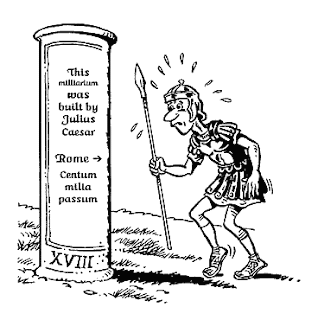Below are some notes outlining the forms of mīlle (1000) and the changes in endings that you will come across when reading. If the aim is to read the language, then the target is to recognise the word – mīlle (Fr. mille; Engl. millennium; mile – notes on that below) – which is straightforward enough.
A common occurrence of mīlle
is in expressing distances. The English noun ‘mile’ is from Old English mīl,
originally a Germanic borrowing from Latin mīlle (passūs) i.e. a thousand paces.
1000 paces = 1 Roman Mile: “a thousand paces as measured by every other step—as
in the total distance of the left foot hitting the ground 1,000 times” calculated
at approximately 1481 metres = 0.92 English miles.
[1] Refer to the image: mīlle
(singular)
[i] mīlle in the singular
does not decline i.e. it is exactly the same as the English ‘one thousand’
mīlle equī │ a thousand horses
mīlle militēs │ one thousand soldiers
In those examples we say that mīlle
is a numeral, no different from an adjective except that it does not agree with
the noun which it is counting
[ii] The noun itself which mīlle
is counting will continue to decline:
Ita cum mīlle equitibus
Māgōne, mīlle peditibus dīmissō … (Livy) │ Mago and / (together)
with his thousand cavalrymen and thousand infantrymen having been thus
dispatched, …
[iii] As you have already seen, certain
other numbers decline and, if used with mīlle, they will continue to
decline even though mīlle itself doesn’t:
cum mīlle [no change] ducentīs
[ablative] virīs (Livy) │ with 1,200 men
ipse ab hostium castrīs nōn
longius mīlle [no change] et quīngentīs [ablative] passibus
abesset (Caesar) │ He himself was no further away than a mile and half [= 1,500
paces] from the enemy’s camp
[iv] What you will also often come
across is mīlle acting like a noun and functioning in the same way as
the genitive construction ‘thousands ¦ of soldiers’; English cannot say a thousand *of
soldiers* whereas Latin can:
Mīlle ¦ militum [genitive
plural] │ a thousand soldiers [ = a thousand ¦ (of) soldiers]
quod mōns suberit circiter mīlle
¦ passuum spatiō (Caesar) │ as there was a mountain nearby about a mile [
= 1000 ¦ (of) paces] off
That is plain sailing for a
Russian speaker; the Russian number tysyacha (1000) is also followed by a
genitive plural.
The example below shows a
combination of [1] and [2] above:
Ipse cum mīlle [1] equitibus
[2] peditumque (Quintus Curtius
Rufus)│ He himself with a
thousand horsemen and footmen
[2] Refer to the image: mīlia (plural)
which may also be written with a double /l/
When the number is a multiple of
1,000 it will become plural with its own case endings, but the noun that it is
counting is in the genitive plural
sex mīlia [nominative
plural] ¦ peditum [genitive plural] │ 6,000 infantry [ = 6,000 (of)
foot soldiers]
fuērunt tria mīlia [nominative
plural] ¦ equōrum [genitive plural] │ there were 3,000 horses [ = 3,000 (of)
horses]
septem mīlia octingentī
[nominative plural] ¦ hostium [genitive plural] ¦ occīsī, duo mīlia
et centum vīgintī [nominative plural] captī (Livy) │ seven thousand eight
hundred ¦ of the enemy ¦ were slain, two thousand one hundred and twenty
taken prisoners
cum Viridovix contrā eum ¦ duōrum
mīlium [genitive plural] ¦ spatiō cōnsēdisset (Caesar) │ while Viridovix
encamped over against him at a distance ¦ of two miles [ = 2,000
(paces)]
cum tribus mīllibus
[ablative plural] ¦ equitum [genitive plural] (Cicero) │ with
3,000 cavalry [= (of) horsemen]
As I mentioned at the start, the
main aim is to recognise the number – especially when it’s in combination with
other numbers – rather than pondering too much about the endings.
Image: mīlliārium, -ī [2/n]: milestone

.svg.png)









